Abstract
The article offers the first complete publication of the hieratic papyrus Cat. 1883 + Cat. 2095. Very little information is available regarding its origin or its owner. However, as the article will show, the document originates within the community of Deir el-Medina during the 20th Dynasty.
1. Introduction
Papyrus Turin Cat. 1883 + Cat. 2095 (https://papyri.museoegizio.it/Object/detail.aspx?!iid=cc962347971e4c43a317c37bd2278281) belongs to the papyrus collection of the Museo Egizio, Turin, purchased as part of the so-called “Collezione Drovetti” (Drovetti Collection) by the king of Savoy, Carlo Felice, between 1823 and 1824.1 Little is known about the papyrus’s find context and place of origin. However, various factors, such as content and palaeography, suggest that it originated from the Theban area, and possibly from the village of Deir el-Medina.2
Although this papyrus has been mentioned occasionally in Egyptological literature since 1876,3 no edition based on the original document complete with images of the papyrus has been published so far. The existing transcriptions and translations into English4 and German,5 though of undoubted value, are based on a facsimile provided by Rossi6 and on unpublished notes collected in Turin by Černý.7 This article aims to fill this gap, providing the first complete publication and edition of the text.
One of the features that has attracted the attention of scholars since 1876 is the name of the king that appears in the first line of the verso. Various attempts have been made to read the name and thereby date the document to the reigns of Ramesses II,8 Ramesses VII,9 or Ramesses IX.10
This will be discussed in detail in the following pages, showing that Ramesses VII is the best candidate.
1.1. Physical description
The papyrus is made up of five directly adjoining fragments (Fig. 1). The larger fragment on the left side of the recto bears the inventory number Cat. 1883, while the four smaller ones on the right side of the recto are inventoried as Cat. 2095.11 The bottom left corner of the larger fragment (Cat. 1883) is not correctly joined to the rest of the papyrus (darker green in Fig. 2). Thus, some of the signs are partially covered or not aligned properly. This becomes clear when looking at the verso, where the long horizontal sign that runs through line 8 drastically changes direction. In its current state, the whole document measures 235 mm in height and 410 mm in length. Two sheet joins are visible, the first one 145 mm, the second 385 mm from the right edge of the papyrus (recto side). Both are around 20 mm wide (21 mm for the left join, 18 mm for the right one), and the right
P. Turin Cat. 1883 + Cat. 2095, verso. The fragments inventoried under number Cat. 1883 are coloured in green, those under inventory number Cat. 2095 in purple. Digital drawing by Martina Landrino. P. Turin Cat. 1883 + Cat. 2095, recto. Digital drawing of the two sheet joins by Martina Landrino.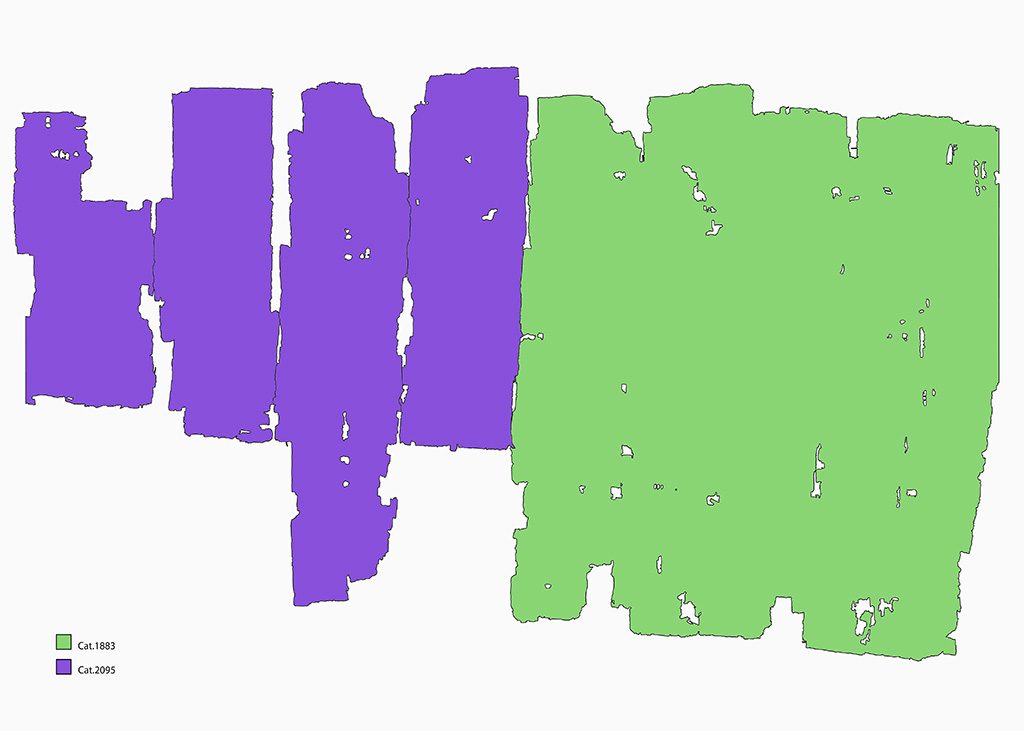
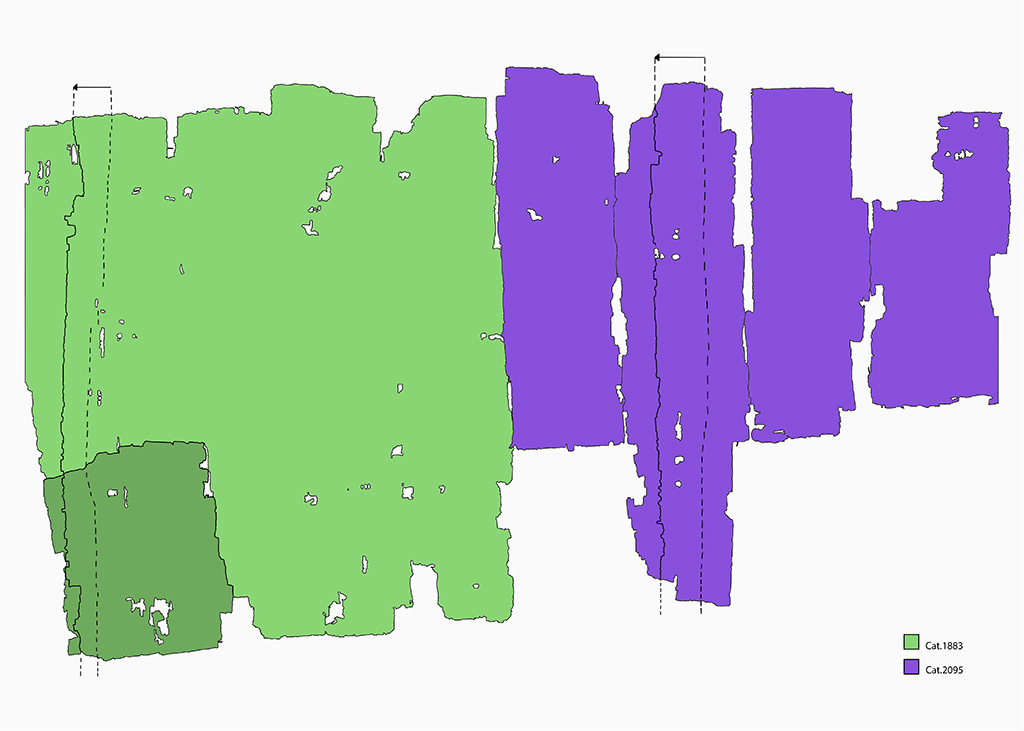
It is uncertain when the fragments were joined and placed in a single frame. In 1926, Černý transcribed the larger fragment (Fig. 3).14 At a subsequent time, he added a red note to the transcription reading: “=Cat. 1883 (+ 2095) see new copy NB 23.55”. The new copy15 (Figs. 4, 5) is the transcription of the whole document, as clearly indicated by the measurements given at the top of the page: “now 22 ¼ x 40 ½ cent.”. Particularly interesting is the use of the word “now”, meaning that the second time Černý saw the text the four smaller fragments had been added to the larger one. Although Černý does not give the exact date on which he worked on the document, a note written some six pages earlier in the same notebook (page 49), mentions the date “19.7.1961”.16 It would seem likely that his notes on P. Turin Cat. 1883 date from a similar point in time, providing a rough terminus ante quem. Thus, the papyrus fragments were most likely joined between 1926 and 1961.
Černý, MSS 3.350. ©Griffith Institute, Oxford.
Černý, NB 23.56. ©Griffith Institute, Oxford.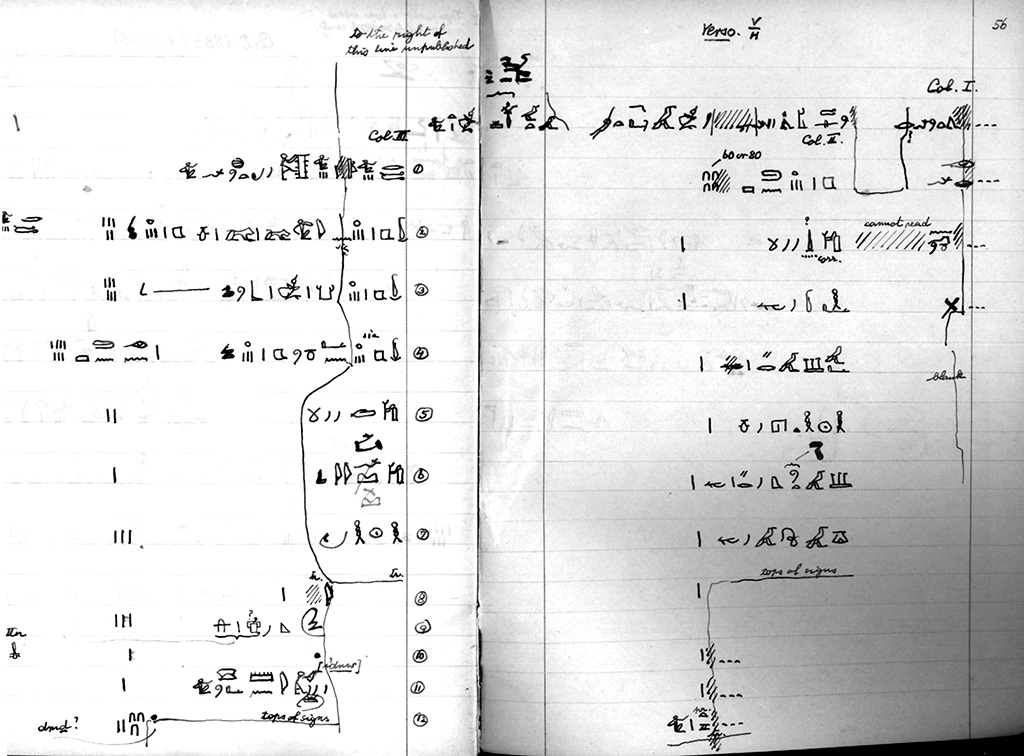
Černý, NB 23.56. ©Griffith Institute, Oxford.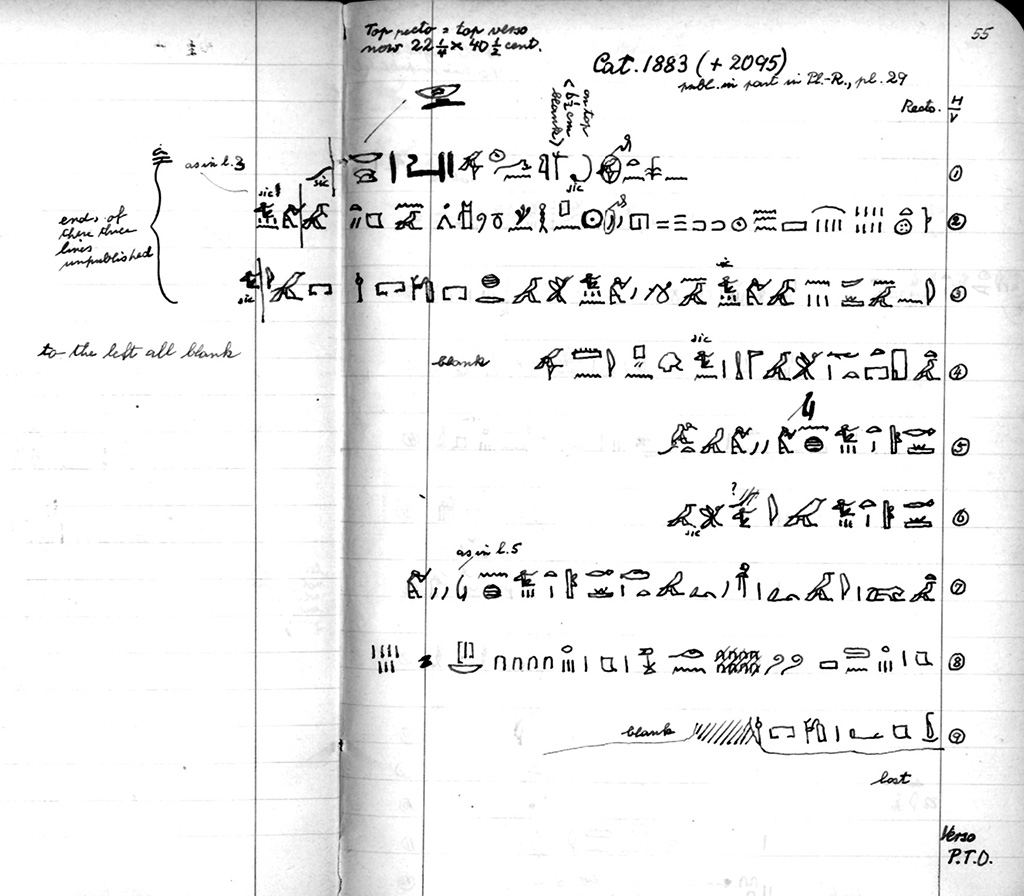
Today, the recto17 (Fig. 6, 7) preserves three columns of text. The first column is composed of four lines, the first of which, with a preserved width of 210 mm, runs across the papyrus, extending above columns 2 and 3. Only the left uppermost part of the first column is preserved to a width of 65 mm; both the second column (63 mm wide) and the third column (224 mm wide) contain twelve lines, of which the bottom parts are only partially preserved. A 5 mm gap divides the first and the second column, while the second and the third are separated by a margin that measures 48 mm. The verso (Figs. 8, 9), written with the same orientation as the recto (meaning the papyrus was flipped over horizontally and not vertically to write on the other side), preserves one column of text with a width of 195 mm, containing nine lines, the first of which is indented by 75 mm. Traces of palimpsest texts are visible on both the recto and verso. An analysis conducted both with the bare eye and the image enhancement software DStretch did not allow for the identification of any specific signs.
P. Turin Cat. 1883 + Cat. 2095, recto, as currently mounted. Scan by Museo Egizio, Turin. Digital processing by Martina Landrino.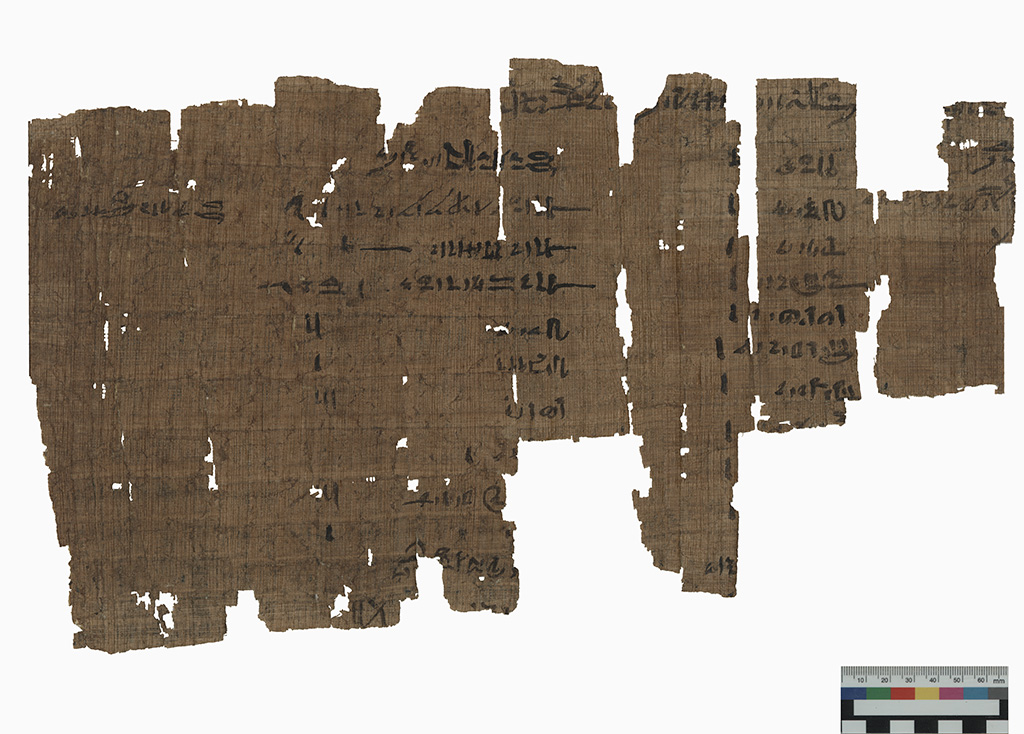
P. Turin Cat. 1883 + Cat. 2095, recto, facsimile. Digital drawing by Martina Landrino.
P. Turin Cat. 1883 + Cat. 2095, verso, as currently mounted. Scan by Museo Egizio, Turin. Digital processing by Martina Landrino.
Turin Cat. 1883 + Cat. 2095, verso, facsimile. Digital drawing by Martina Landrino.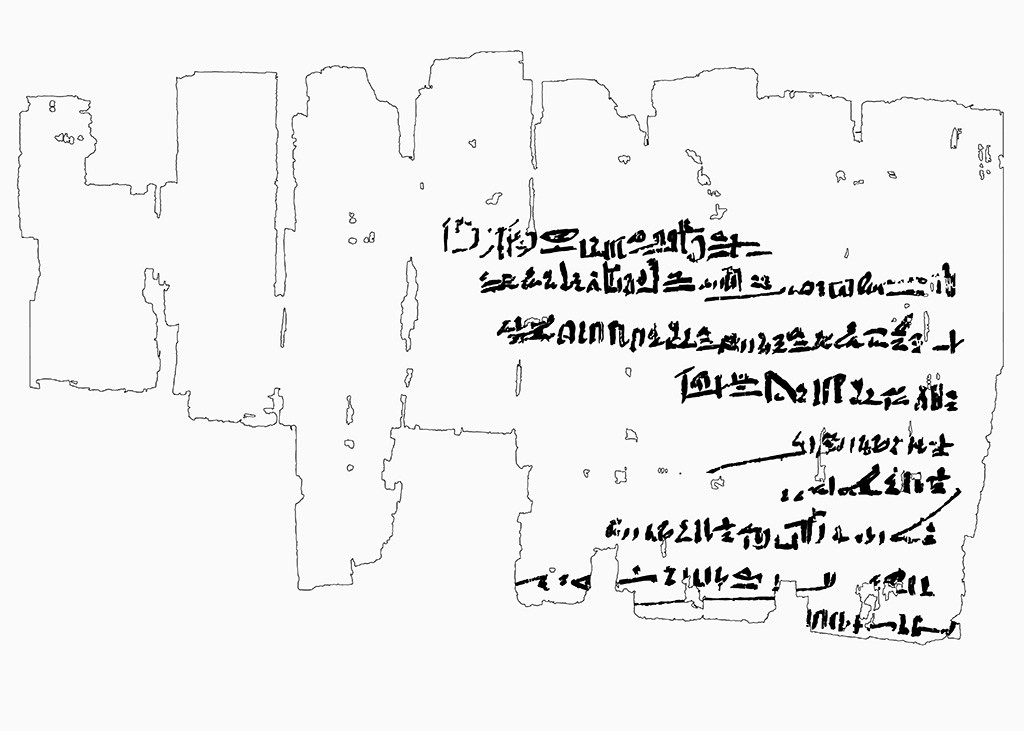
In the Ramesside period, the average height of a papyrus sheet was about 420 mm. If this is also true of the document at hand, then only its upper part is preserved. However, scribes often cut papyrus sheets in half or even into quarters for more convenient use.18 Since neither the text on the recto nor that on the verso can indicate whether this was a standard or half-height roll, it is impossible to reconstruct the exact dimensions of the papyrus.
2. Transcription, transliteration, translation and commentary
2.1 Recto
2.1.1 Col. 1

(l. 1)
(l. 2)
(l. 3)
(l. 4) […] 30
(l. 1) […] He is raised (he is denounced?) [… …] He is raised (he is denounced?) [ …] one takes the office of the vizier.
(l. 2) […] He did
(l. 3) […]? the ??
(l. 4) […] 30
Line 1
The reading of the signs at the beginning of the line is debatable. The first word is completely lost except for the determinative of the “legs” (D54) followed by a pronoun. Since the same combination is repeated after the verb
Line 3
If Černý’s judgement (“sehr schlecht geschrieben”)23 seemed a bit harsh until now, this line matches the description perfectly. At first glance, the signs are clearly legible. Upon closer observation, it is difficult to identify them. It is even more problematic to make sense of them. I was unable to, so I must leave this line untranscribed and untranslated.24
Line 4
Černý left this sign untranscribed. A comparison with the sign “30” written in Col. 3 – line 12 shows that the two signs look similar, hence the reading suggested here.
2.1.2 Col. 2
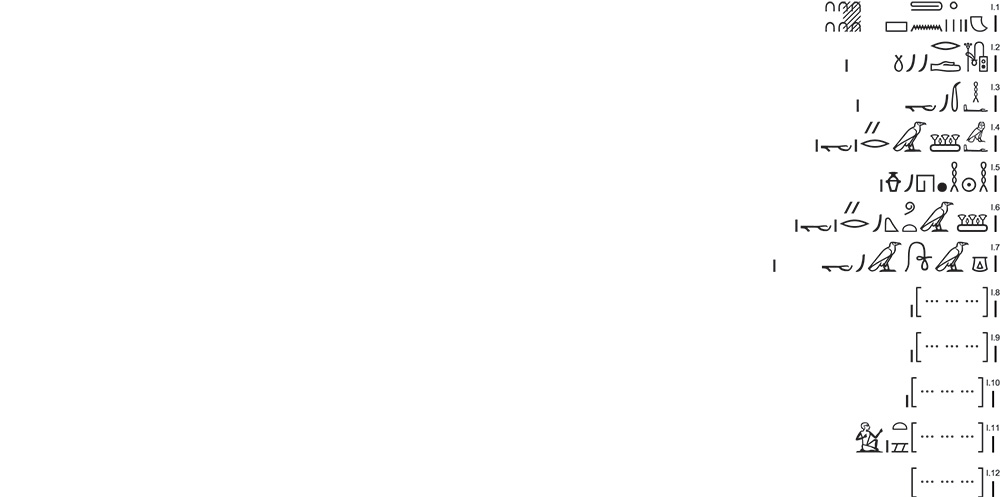
(l. 1)
(l. 2)
(l. 3)
(l. 4)
(l. 5)
(l. 6)
(l. 7)
(l. 8) […] 1
(l. 9) […] 1
(l. 10) […] 1
(l. 11) […] ?
(l. 12) […] (traces)
(l. 1) Copper, deben, 60(+x)
(l. 2) Smooth cloth,
(l. 3) Bed, 1
(l. 4)
(l. 5)
(l. 6)
(l. 7)
(l. 8) […] 1
(l. 9) […] 1
(l. 10) […] 1
(l. 11) […] ?
(l. 12) […] (traces)
Line 1
The line is neither transcribed nor translated by Kitchen.25
It has been interpreted either as a continuation of the second line of the first column26 or as the first line of the second column.27 It starts at the same height as the first line of Col. 3, and is aligned with the other lines belonging to Col. 2. Furthermore, before and after the lacuna (which splits Col. 1 – line 2 and Col. 2 – line 1) there are rather large blank spaces visible. Even though blank spaces are also evident in other areas of the text, they always occur between a word and a number. Therefore, I find Černý’s interpretation (first line of Col. 3) more likely to be correct. However, it is not possible to dismiss the other theory completely.
Line 2
After the scribal palette (Y3), the scribe made a correction, overlapping two signs onto others. Both the scribal palette and the determinative of the word itself clarify that the item mentioned is a textile or a garment of some sort. In his notebook, Černý suggested to read the first sign as
Line 4
The word
Line 5
The word
The word
Line 6
The wooden container known as
Line 7
The last preserved word in the column is
2.1.3 Col. 3
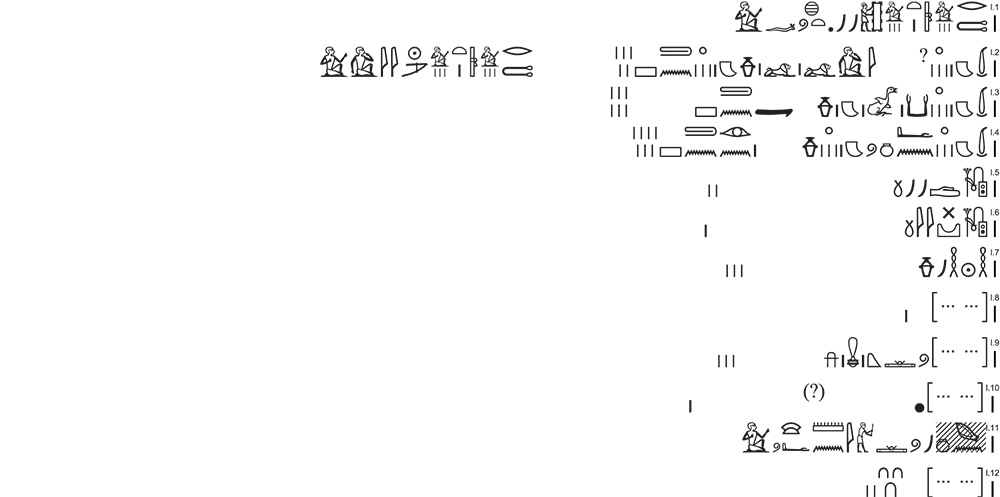
(l. 1)
(l. 2)
(l. 3)
(l. 4)
(l. 5)
(l. 6)
(l. 7)
(l. 8) [… …] 1
(l. 9)
(l. 10) [… …]? 1
(l. 11)
(l. 12) [… … …] 32
(l. 1) Workman Qedakhtef
(l. 2) Bronze,
(l. 3) Bronze,
(l. 4) Bronze,
(l. 5) Smooth cloth, kilt, 2
(l. 6) Smooth cloth, loincloth, 1
(l. 7)
(l. 8) [… …] 1
(l. 9) [… …] ? 3
(l. 10) [… …] ? 1
(l. 11) [Depu]ty Amenkhau
(l. 12)
Line 2
The first word in this line has been interpreted as “bronze” or “chisel”.40 Due to the presence of the combined mineral determinatives and the following word
Line 3
The same interpretation is applied to this line. Thus, the first word should be “bronze”, followed by a second metal container. Černý transcribed this word as
Line 4
So far, the object listed has been read as
Line 5
Various translations have been proposed for the word
Line 6
The
Line 7
The
Line 8
The only sign legible is the number 1; the other traces are too poorly preserved to be legible.
Line 9
Due to the determinative (V19), this entry possibly lists a basket. I am not able to provide a suggestion regarding its name.
Line 11
The first word in this line is only partially preserved. Its position in front of a name suggests that it could be a title. I agree with Černý’s suggestion to read it as
Line 12
The traces at the beginning of this line are too poorly preserved to be legible. The following number indicates a rather large amount compared to the other numbers present in the same column. Whether this is the indication of the total price of the objects listed above, it is difficult to say, since some objects are listed with their prices in deben, while for others only the quantity is given and not their worth.
2.1.4 Comment on content and writing
The beginning of the recto is highly damaged. From what is preserved it is difficult to understand if it is related to the commissioning of the tools described on the verso. Therefore, I treat them separately.
The meaning of Col. 1 is unclear, especially that of the first line. The suffix pronoun
The other columns contain an inventory of various items, such as garments, woodwork, and metalwork. In Col. 2, the objects are registered with their quantity and not their value. Perhaps the first entry, “X deben of copper”, indicates their total sum – although the sum is usually indicated at the end of lists and preceded by the word
At least three people were involved: two workmen named Qedakhtef and Meryre, and a deputy named Amenkhau. Possibly, another name was written in Col. 2 – line 1, but the traces are not legible. The deputy Amenkhau is the only one who is clearly identifiable. There is indeed only one deputy recorded under this name, Amenkhau (i).61 The identification of the two workmen is a more complicated matter. Four different workmen are recorded with the name Qedakhtef. Davies identified the one mentioned in the text with either Qedakhtef (iii) or (iv), following Bierbrier’s interpretation.62 For Meryre, Davies lists four workmen under that name. He narrows the possibilities down to Meryre (vi) and (vii). However, neither seems to fit within the context, one being too early, the other too late.63 The interpretations are based on chronological evidence. Davies dates the text on the recto to year 8 of Ramesses VII. Even though the verso is clearly dated to that period, the recto could be of a different date. The presence of the deputy Amenkhau could indeed be an indicator of this, as he was in office from year 17 of Ramesses III to year 7 of Ramesses IV.64 Therefore the text on the recto could be earlier and mention the older Qedakhtef (i) or (ii), and Meryre (iv) or (vi). On the basis of the information preserved, their identification cannot be narrowed down any further.
Similar texts, describing smaller transactions, are often written on ostraca rather than papyri.65 The majority of these documents have been analysed under several respects as inexhaustible sources for the study of the daily life of the workmen of Deir el-Medina. As a result, not only their content but also their vocabulary is well-known, allowing a comparison with the text presented in this study. Among the items mentioned, some are commonly present in documents, e.g., the
The first object listed in O. Turin Suppl. 9765A + O. DeM 105 is
2.2 Verso

(l. 1)
(l. 2)
(l. 3)
(l. 4)
(l. 5)
(l. 6)
(l. 7)
(l. 8)
(l. 9)
(l. 1) Of the King Usermaatra Setepenra, son of Re, Lord of Crowns, Itamun.
(l. 2) Regnal year 8, 4th month of shemu, day 25, this day: commissioning the coppersmiths
(l. 3) By the captains and the
(l. 4) The temple, <under> the authority of the high priest of Amun,
(l. 5) The chief workman, Nekhemmut,
(l. 6) (And) the chief workman, Harmose, the (sic)
(l. 7) the right side, from the chief workman, Nekhe<mmut>:
(l. 8) Copper, deben 280; making spikes, 40; each [one], deben 7; […]
(l. 9) Chisel (?), in the charge of the scribe of the treasury […]
Line 1
Its position indented by 75 mm in respect to the other lines clarifies that this is an addition to line 2, to be inserted after the date.71
In his notes, Černý described the document as “sehr schlecht geschrieben”.72 This applies particularly to the royal titulary, where the reading of some signs is still doubtful. For the convenience of the reader, the previous transcriptions are listed below in chronological order:
1- Černý (1st):73 
2 – Černý (2nd):74 
3 – Eyre:75 
4 – Kitchen:76 
The first four signs can be read clearly; however, scholars differ on the transcription of the following
P. Turin Cat. 1883 + Cat. 2095, verso: detail of line 1.
The hieratic signs that follow (Fig. 10) are more difficult to explain. Černý (1st) transcribed them as the closing of the cartouche and the epithet “Son of Re” with an ideogram stroke behind it  . In his second transcription he did not transcribe them at all, leaving the signs in their hieratic form. Eyre, followed by Kitchen, saw a defective writing of the name
. In his second transcription he did not transcribe them at all, leaving the signs in their hieratic form. Eyre, followed by Kitchen, saw a defective writing of the name
P. Turin Cat. 1891, recto: detail of line 1.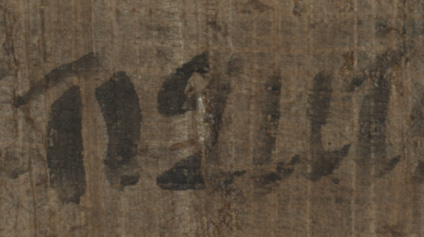
Turin Cat. 1891 is also relevant for the interpretation of the next hieratic group. Černý and Eyre presented two different transcriptions. The first recognized the signs as a badly executed writing of “Lord of Crowns”, the second as “Lord of the Two Lands”. The same group, at the end of line 1 of P. Turin Cat. 1891, has been read invariably as “Lord of Crowns”. This interpretation is proved true by two considerations: the title “Lords of the Two Lands” already appears earlier in the line, and the title “Lord of Crowns”, in combination with “Son of Re”, is expected as an introduction for the second cartouche.81
When Černý saw the papyrus for the first time in 1926, the document had not yet been joined together. He could only work on the larger fragment. His first transcription ends with the opening of the second cartouche. Indeed, after the praenomen of the Pharaoh one would normally expect the nomen. This hypothesis was strengthened by the presence of the epithets that normally introduce the second cartouche, i.e., “Son of Re” and “Lord of Crowns”. The second time he worked on the document, however, when the papyrus had been joined with the other fragments, Černý was confronted with a blank space instead of the expected cartouche.82 He consequently modified his first transcription, choosing not to read the title “Son of Re” and converting the opening of the cartouche into a simple oblique stroke followed by “sic” (Fig. 5).
Among the editors who worked on this text, Černý was the only one who saw the original document.83 All other transcriptions are based on his notes. With the help of DStretch,84 it has been possible to obtain an image with enhanced details, revealing traces of ink that are difficult to see with the naked eye. In particular, this investigation has revealed the second cartouche with the nomen of Ramesses VII (Fig. 12). The addition of the sun disk right after the opening of the cartouche, although not necessary, is a well-known phenomenon that occurs both on ostraca and in papyri.85 The signs that follow are interfered with by some heavy traces of palimpsest.
(Fig. 12). The addition of the sun disk right after the opening of the cartouche, although not necessary, is a well-known phenomenon that occurs both on ostraca and in papyri.85 The signs that follow are interfered with by some heavy traces of palimpsest.
P. Turin Cat. 1883 + Cat. 2095, verso: detail of line 1. Dstretch(lbk) manipulation by Martina Landrino.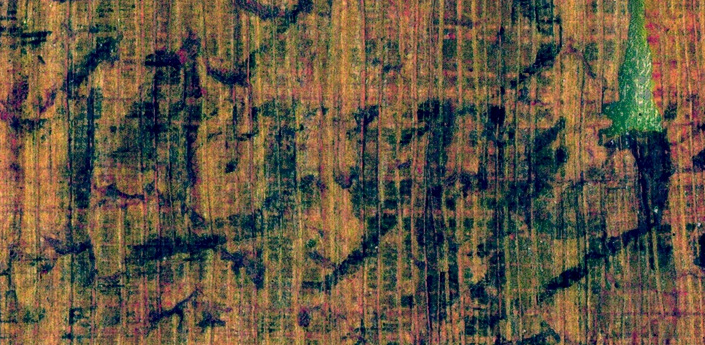
Line 2
The verb
The line ends with some faded, yet legible, signs. These are the determinatives for the word
Line 3
The word “captains” occurs with two different spellings:
Line 4
The scribe omitted the
The scribe also inserted a superfluous horizontal stroke underneath the “seated man” (A1). Either the stroke represents the “water ripples” (N35) and should be read as
Line 5
The chief workman of the right side, Nekhemmut (vi),92 is a well-known character. His name is spelt here in a unique way. After the ligature
Line 6
The name Harmose is composed of two parts. The first, a “falcon” (G5) followed by a “reed leaf” (M17) which is still preserved, the second, an “oblique stroke” (Z5) on top of a “seated man” (A1), the latter sign being damaged. The reading is complicated by the modern assemblage of the fragments. As already pointed out above, the two adjoining fragments are imperfectly joined.94 Thus, the upper sign merges with the lower one.
The last two signs – aligned differently because of the misplacement of the papyrus fragments – are possibly what remains of the second part of Harmose’s title, the complete form of which is “chief workman of the Tomb”. While the first part is written before the personal name, the second one (
Line 7
The spelling of the name Nekhemmut is similar to the one analyzed in line 5. The first part is written
Line 8
I translate the word
Line 9
This line is rather damaged and the reading proposed here is far from certain.
The word at the beginning of the line,  , has been read as
, has been read as
Turin Cat. 1883 + Cat. 2095, verso: detail of beginning of line 9.
Although, the presence of the
The following signs, a long horizontal line and a vertical stroke crossed by a small horizonal stroke, have been invariably transcribed by the scholars who studied the papyrus as an “arm” (D36) followed by an “ideogram stroke” (Z1).105 The identification of the vertical stroke as an “ideogram stroke” is not prevented by the presence of a horizontal line going across it.106 The scholars who studied the papyrus translated the word
Little can be said on how the line continued. Most likely, the title was followed by a name. Perhaps another attestation of the scribe of the temple treasury, Hori.
The workforce of Deir el-Medina was equipped daily with state-owned tools for their tomb-construction work. The administration of the “Tomb” was responsible for the manufacturing, delivery, and collection of these tools. Once they were worn out, they were handed over to coppersmiths to be recast into new tools.110 This last activity is described on the verso of Pap. Turin Cat. 1883 + Cat. 2095. Different authorities were present to oversee it: the captains and the
As for the amount of deben indicated in the text, do they represent the price or the weight of the spikes? The examination of different written sources relative to metal objects and tools led Janssen to the conclusion that the answer can vary depending on the text, some texts mentioning the price and others the weight. It should also be taken into account that in the case of simple tools such as spikes there may be a small difference between price and weight.117 Due to their rather high weight, Janssen thought that the word
Turin Suppl. 7514. ©Museo Egizio Torino.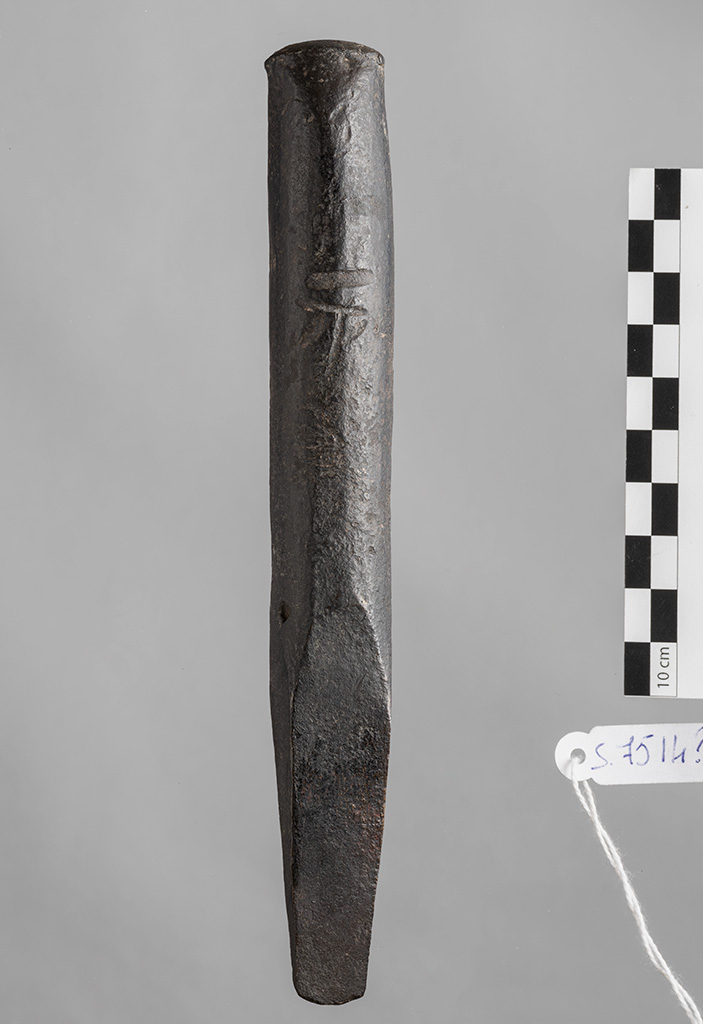
Turin Suppl. 7517. ©Museo Egizio Torino.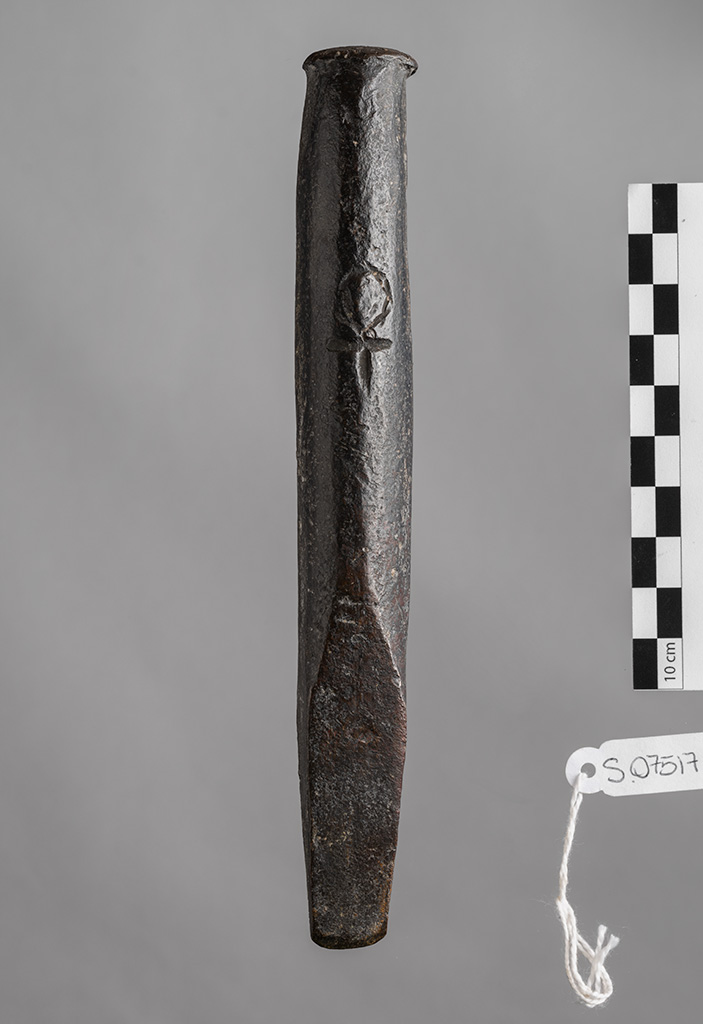
The copper is handed over by the “chief workman of the right side”. His colleague, the “chief workman
3. The date of the text
So far, the most debated question has been that of the date of the document. In 1876 Pleyte translated the heading as “Du roi (sutu) Ra. usr. ma stp. n. ra anχ ut’a snb, seigneur des diadèmes”.125 He recognized the praenomen of Ramesses II and therefore assigned the text to his reign. This theory was then accepted by the compilers of the first catalogue of the Egyptian antiquities housed in Turin.126 However, the identification with Ramesses II already appeared problematic for scholars at the beginning of the 20th century.
The main issue was the presence of the two foremen, Nekhemmut and Harmose. They are attested as serving together only under the reign of Ramesses IX. Peet suggested that the document should be dated to this reign and that the first line is not part of the date.127 He did not offer any explanation as to why the name of Ramesses II was present in the heading of a document drafted a hundred years later. For the next fifty years, this hypothesis was accepted within the scientific community. However, doubts remained. For instance, Janssen assigned the papyrus to Ramesses IX, pointing out, though, that “Year 8 can only belong to the reign of Ramesses IX – unless Ramesses VII also reigned more than 7 years, which is not impossible”.128
A solution that accounted for both the praenomen and the people mentioned in the text was proposed in 1980 by Eyre, who showed that the reign of Ramesses VII is the only plausible date for the text.129 Contrary to what Peet thought, the first line of the text does belong to it and is part of the date. The confusion was generated by the correspondence of the praenomen of Ramesses VII with that of Ramesses II. It has been already discussed at length that the heading preserves not only the praenomen of Ramesses VII but also his nomen, leaving no doubt that the reference is to this king.130
The recto did not attract the attention of the scholars as much as the verso did. Pleyte and Rossi did not spend much effort describing it – “les débris du revers sont de peu d’importance” – and no facsimile was provided.131 In previous studies, it has been assumed that the recto dates to the same period. This hypothesis is paleographically possible, since it appears indeed to be written by the same scribe.132 As already pointed out above, the relationship between the texts on the recto and that on the verso is not clear. Furthermore, it is difficult to understand whether the three columns on the recto belong to a single text.
Concerning the note on the vizier, the content does not provide any hints (e.g., regnal date or names) about the period it dates from. The inventory, on the contrary, does contain some scant information. For instance, the names of the people involved. The presence of the deputy Amenkhau is particularly interesting, his activity spanning the reigns of Ramesses III and Ramesses IV.133 It is reasonable to assume that this list was drawn up within that chronological span, specifically, from year 17 of Ramesses III to year 7 of Ramesses IV. The other two names preserved do not allow us to further narrow down the time span. Nevertheless, one should not overlook the possibility that the text is either a copy of an earlier document or mentions it, and was indeed written in the reign of Ramesses VII.
4. Scribal practice
As said above, the texts on the recto and verso were probably written by the same scribe, who is also the author of P. Turin Cat. 1891, as a comparison between distinctive signs shows (Table 1). One of the peculiar features of this scribe’s handwriting is the
A comparison of significant signs in P. Turin Cat. 1883 + Cat. 2095, recto and verso, and P. Turin 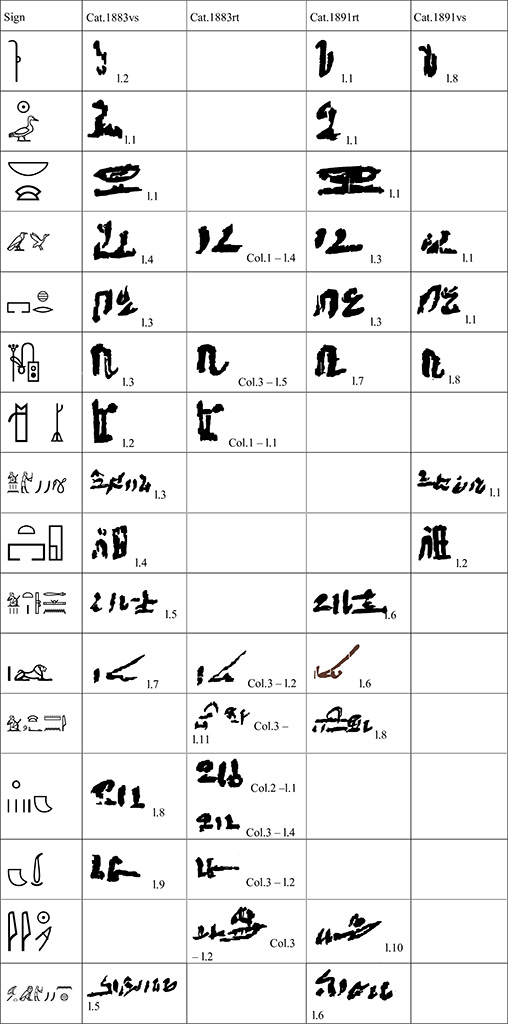
On the basis of the dates of these papyri, it can be assumed that this scribe was active during a period that runs at least from the 2nd year of Ramesses IV to the 11th year of Ramesses IX.134 It is tempting to try to assign a precise identity to the scribe comparing this time frame with the known chronologies of individuals bearing the title of “scribe of the Tomb”.135 Such an attempt is not without risk. It is reasonable to guess that the author of texts such as the recto of both P. Turin Cat. 1883 and P. Turin Cat. 1891 would have served in the administration of the village as a scribe. One should also consider that at Deir el-Medina the percentage of literates was higher than in the rest of Egypt. The scribes were not the only ones able to read and write.136 Consequently, it is impossible to be certain that the writer of the documents officially bore the title of scribe. Therefore, in this case an identification based only on the chronology of “scribes of the Tomb” is not a valid approach.
Finally, the last issue that should be addressed regards the materiality of the document itself. The papyrus, as we see it today, is the outcome of a writing and erasure process:
- The recto was inscribed. It bears scant traces of a previous, erased text, especially in the upper-right corner and at the bottom. The original extension of the text(s) and their content are not identifiable. The verso was inscribed. The enhanced images obtained with DStretch (Fig. 12)137 show the traces of a two-column palimpsest text that runs to full height, covering the entire surface of the papyrus. The surviving evidence does not allow an understanding of the original extension of the text or its content.
- The recto was erased and used again. As already discussed above, the inventory on the recto dates to an earlier period than the verso,138 suggesting that the recto was reused before the verso was used. To date, the recto preserves two different texts. The layout can provide some hints about the order in which these texts were written. The 1st column is compressed and almost no space separates it from the 2nd. Contrary to this, the 2nd and the 3rd columns are divided by a rather large space. It is possible that the inventory was already present on the papyrus and the other text was written in the blank spaces around the existing text.
- The last phase is the reuse of the verso, which is erased and written again. The newly written text occupies only a small portion of the papyrus sheet and a high margin is left blank at the top of the document.
“Biography” of P. Turin Cat. 1883 + Cat. 2095. Video by Martina Landrino.Video 1
The above recreated “biography” (Video 1) is hypothetical. We need to allow for the possibility, for instance, that the inventory was a later copy of an older text. In this case, it is not possible to determine if it was written before or after the verso. The reproduction of information from one source to another, especially from ostraca to papyri, is a well-attested process.139 The possible reason for copying such information onto another writing surface is difficult to establish in this case.
The last question that needs to be addressed is how the papyrus was kept by its owner(s). A number of vertical breaks run in a “wavy” pattern throughout the surface of the papyrus at regular intervals, thus fitting into Krutzsch’s category B, “wellig”. According to Krutzsc, these traces are primary breaks caused by rolling up the sheet.140 The papyrus preserves five windings:
- an incomplete one, measuring 24 mm;
- four complete ones, measuring respectively (from left to right) 80 mm, 90 mm, 96 mm, 105 mm.
Flattening the scroll onto itself caused the fractures that run in the middle of the windings. The increasing dimensions of the windings from left to right indicate that the papyrus was rolled up starting on the left side and leaving the right side exposed.141 In Video 1, each winding received a different color gradually getting darker when approaching the interior of the scroll. Based on the measurements of the breaks, the preserved sheet should have had a maximum circumference of 105 mm with an approximate diameter of 33.4 mm.142
Bibliography
Allam, Schafik, “Sind die nichtliterarischen Schriftostraka Brouillons?”, JEA 54 (1968), pp. 121–28.
Beckerath, Jürgen von, Handbuch der ägyptischen Königsnamen (MÄS 49), Mainz 1999.
Bierbrier, Morris L., “Notes de prosopographie thébaine”, CdE 59 (1984), pp. 199–241.
Botti, Giuseppe and Thomas E. Peet, Il Giornale della necropoli di Tebe, Torino 1928.
Černý, Jaroslav, “Le culte d’Amenophis I chez les ouvriers de la Nécropole thébaine [avec 9 planches]”, BIFAO 27 (1927), pp. 159–203.
Černý, Jaroslav, Catalogue des ostraca hiératiques non littéraires de Deir el Médineh (DFIFAO 3), Caire 1935.
Černý, Jaroslav, Catalogue des ostraca hiératiques non littéraires de Deir el Médineh (DFIFAO 7), Caire 1951.
Černý, Jaroslav, Paper and Books in Ancient Egypt: An Inaugural Lecture Delivered at University College London, 29 May 1947, London 1952.
Černý, Jaroslav, A Community of Workmen at Thebes in the Ramesside Period (Bibliotèque d’ Étude 50), Caire 20012.
Černý, Jaroslav and Sarah I. Groll, A Late Egyptian Grammar (Studia Pohl: Series Maior 4), Rome 19843.
Davies, Benedict G., “O. Berlin P. 11239 and the Coppersmiths at Deir el-Medina”, GöttMisz 137 (1993), pp. 39–47.
Davies, Benedict G., Who’s Who at Deir el-Medina: A Prosopographical Study of the Royal Workmen’s Community (EgUit 13), Leiden 1999.
Donker Van Heel, Koenraad and Ben J. J. Haring, Writing in a Workmen’s Village: Scribal Practice in Ramesside Deir el-Medina (EgUit 16), Leiden 2003.
Erichsen, Wolja, Papyrus Harris I: Hieroglypische Transkription (BiAeg 5), Bruxelles 1933.
Erman, Adolf and Hermann Grapow (eds.), Wörterbuch der ägyptischen Sprache, I–VII, Leipzig and Berlin 1926–1963.
Eyre, Christopher J., “The Reign-Length of Ramesses VII”, JEA 66 (1980), pp. 168–70.
Eyre, Christopher J., The Use of Documents in Pharaonic Egypt (Oxford Studies in Ancient Documents), Oxford 2013.
Fabretti, Ariodante, Francesco Rossi and Ridolfo V. Lanzone, Regio Museo di Torino. Antichità Egizie, I (Catalogo generale dei musei di antichità e degli oggetti d’arte raccolti nelle gallerie e biblioteche del regno, 1. Piemonte), Torino 1882.
Fischer-Elfert, Hans-W., “In Praise of Pi-Ramesse – A Perfect Trading Center (including two new Semitic words in syllabic orthography; Ostr. Ashmolean Museum HO 1187)”, in: Collombert, Philippe, Dominique Lefèvre, Stéphane Polis and Jean Winand (eds.), Aere Perennius. Mélanges Égyptologiques en l’Honneur de Pascal Vernus (OLA 242), Leuven – Paris – Bristol 2016, pp. 195–218.
Fischer-Elfert, Hans-W., review of Navrátilová, Hana, Visitors’ Graffiti of Dynasties 18 and 19 in Abusir and Northern Saqqara: With a Survey of the Graffiti at Giza, Southern Saqqara, Dahshur and Maidum, Abercromby 20152, BiOr 74/3–4 (2017), pp. 328–34.
Flinders Petrie, William M., Tools and Weapons. Illustrated by the Egyptian Collection in University College, London, and 2000 Outlines from Other Sources (BSAE 30), London 1917.
Gabler, Kathrin, Who’s Who Around Deir el-Medina. Untersuchungen zur Organisation, Prosopographie und Entwicklung des Versorgungspersonals für die Arbeitersiedlung und das Tal der Könige (EgUit 31), Leuven 2018.
Gabler, Kathrin and Matthias Müller, “A Vizier’s (Maybe Not So) New Pieces of Furniture in the Renaissance Era”, in: Kathrin Gabler, Rita Gautschy, Lukas Bohnenkämper, Hanna Jenni, Clémentine Reymond, Ruth Zillhardt, Andrea Loprieno-Gnirs, and Hans-Hubertus Münch (eds.), Text-Bild-Objekte im archäologischen Kontext. Festschrift für Susanne Bickel, Hamburg 2020, pp. 117–50.
Gardiner, Alan H., Late-Egyptian Miscellanies (BiAeg 7), Bruxelles 1937.
Gardiner, Alan H., The Wilbour Papyrus, II, Oxford 1948.
Hagen, Fredrik and Daniel Soliman, “Archives in Ancient Egypt, 2500-1000 BCE”, in: Alessandro Bausi, Christian Brockmann, Michael Friedrich, and Sabine Kienitz (eds.), Manuscripts and Archives (Studies in Manuscript Cultures 9), Berlin 2018, pp. 71–170.
Haring, Ben J. J., Divine Households. Administrative and Economic Aspects of the New Kingdom Royal Memorial Temples in Western Thebes (EgUit 12), Leiden 1997.
Haring, Ben J. J., “Material Matters: Documentary Papyri and Ostraka in Late Ramesside Thebes”, in Francisca A. J. Hoogendijk and Steffie van Gompel (eds.), The Materiality of Texts from Ancient Egypt: New Approaches to the Study of Textual Material from the Early Pharaonic to the Late Antique Period (P.L.Bat. 35), Leiden–Boston 2018, pp. 44–51.
Helck, Wolfgang, Materialien zur Wirtschaftsgeschichte des Neuen Reiches (Teil VI) (Akademie der Wissenschaften und der Literatur (Mainz): Abhandlungen der Geistes- und Sozialwissenschaftlichen Klasse 1969 [4]), Wiesbaden 1969.
Helck, Wolfgang, Die datierten und datierbaren Ostraka, Papyri und Graffiti von Deir el-Medineh (ÄgAbh 63), Wiesbaden 2002.
Janssen, Jacob J., Commodity Prices from the Ramesside Period: An Economic Study of the Village of Necropolis Workmen at Thebes, Leiden 1975.
Janssen, Jacob J, “A Draughtsman Who Became Scribe of the Tomb: Harshīre, son of Amennakhtĕ”, in: Robert J. Demarée and Jac. J. Janssen (eds.), Gleanings from Deir el-Medina (EgUit 12), Leiden 1982, pp. 149–53.
Janssen, Jacob J., “An Exceptional Event at Deir el-Medina (P. Turin 1879, Verso II)”, JARCE 31 (1994), pp. 91–97.
Janssen, Jacob J., “Visits to the Necropolis by Dignitaries”, in Jacob J. Janssen (ed.), Village Varia. Ten Studies on the History and Administration of Deir el-Medina (EgUit 11), Leiden 1997, pp. 147–73.
Janssen, Jacob J., Daily Dress at Deir el-Medina: Words for Clothing (Golden House Publications Egyptology 8), London 2008.
Janssen, Jacob J., Furniture at Deir el-Medina: Including Wooden Containers of the New Kingdom and Ostracon Varille 19 (Golden House Publications Egyptology 9), London 2009.
Jarsaillon, Carole, “Schiaparelli et les archéologues italiens aux bords du Nil : égyptologie et rivalités diplomatiques entre 1882 et 1922”, RiME 1 (2017). DOI: 10.29353/rime.2017.1231
Kitchen, Kenneth A., Ramesside Inscriptions, historical and biographical, IV, VI, Oxford 1982–1983.
Kitchen, Kenneth A., Ramesside Inscriptions Translated & Annotated: Translations, IV, VI, Oxford, Singapore 2003–2012.
Krutzsch, Myriam, “Blattklebungen erkennen und dokumentieren”, in: Jörg Graf and Myriam Krutzsch (eds.), Ägypten lesbar machen – die klassische Konservierung/Restaurierung von Papyri und neuere Verfahren: Beiträge des 1. Internationalen Workshops der Papyrusrestauratoren, Leipzig 7.–9. September 2006 (Archiv für Papyrusforschung – Beiheft 24), Berlin 2008, pp. 71–83.
Krutzsch, Myriam, “Falttechniken an altägyptischen Handschriften”, in: Jörg Graf and Myriam Krutzsch (eds.), Ägypten lesbar machen – die klassische Konservierung/Restaurierung von Papyri und neuere Verfahren: Beiträge des 1. Internationalen Workshops der Papyrusrestauratoren, Leipzig 7.–9. September 2006 (Archiv für Papyrusforschung – Beiheft 24), Berlin 2008, pp. 93–98.
Krutzsch, Myriam, “Einzelblatt und Rolle: Zur Anatomie von Papyrushandschriften”, in: Feder, Frank, Gunnar Sperveslage, and Florian Steinborn (eds.), Ägypten begreifen: Erika Endesfelder in memoriam (IBAES 19), Berlin and London 2017, pp. 213–22.
Lesko, Leonard H. and Barbara S. Lesko, A Dictionary of Late Egyptian, III, IV, Providence 1987–1989.
Lopez, Jesus, Ostraca ieratici N. 57450–57568 (CMT, Serie seconda – collezioni 3), I-IV, Milano 1978-1984.
Möller, Georg, Hieratische Paläographie. Die ägyptische Buchschrift in ihrer Entwicklung von der Fünften Dynastie bis zur Römischen Kaiserzeit, II, Leipzig 1909.
Müller, Matthias, “Es werde Licht? Eine kurze Geschichte von Öl & Fett in Deir el-Medina in der 20. Dynastie”, in: Ben J.J. Haring, Olaf E. Kaper, and René van Walsem (eds.), The Workman’s Progress. Studies in the Village of Deir el-Medina and Other Documents from Western Thebes in Honour of Rob Demarée (EgUit 28), Leiden 2014, pp. 175–90.
Peet, Eric T., “An Ancient Egyptian Ship’s Log”, BIFAO 30 (1930), pp. 481–90.
Peust, Carsten, “Die Konjugation des Verbs für ‚gehen‘ im Neuägyptischen”, GM 212 (2012), pp. 67–80.
Pleyte, Willem and Francesco Rossi, Papyrus de Turin, Leiden 1876.
Quack, Joachim F., “Zur Frage der botanischen Natur des
Ranke, Hermann, Die ägyptischen Personennamen, I, Glückstadt 1935.
Reeves, Nicholas and Richard H. Wilkinson, The Complete Valley of the Kings: Tombs and Treasures of Egypt’s Greatest Pharaohs, London 1997.
Sauneron, Serge, Catalogue des ostraca hiératiques non littéraires de Deir el-Médineh (DFIFAO 13), Caire 1959.
Schiaparelli, Ernesto, Relazione sui lavori della Missione archeologica italiana in Egitto (anni 1903–1920), II: la tomba intatta dell’architetto Kha, Torino 1927.
Sethe, Kurt, “Der Name Sesostris”, ZÄS 41 (1904), pp. 43–57.
Sethe, Kurt, Urkunden der 18. Dynastie., III (Historisch-biographische Urkunden), Leipzig 1907.
Tropper, Josef, Kleines Wörterbuch des Ugaritischen (Elementa Linguarum Orientis 4), Wiesbaden 2008.
Valbelle, Dominique, Catalogue des poids à inscriptions hiératiques de Deir el-Médineh : n. 5001–5423 (DFIFAO 16), Caire 1977.
Valbelle, Dominique, «Les ouvriers de la tombe»: Deir el-Médineh à l’époque ramesside (Bibliotèque d’Étude 96), Caire 1985.
Van der Molen, Rami, A Hieroglyphic Dictionary of Egyptian Coffin Texts (ProblÄg 15), Leiden – Boston – Köln 2000.
Wimmer, Stefan, Hieratische Paläographie der nicht-literarischen Ostraka der 19. und 20. Dynastie, I–II (AAT 28), Wiesbaden 1995.
Online sources
The Deir el-Medina Database, https://dmd.wepwawet.nl/, compiled by Koen Donker van Heel; Robert J. Demarée; Ben J. J. Haring; Jaana Toivari-Viitala, Leiden 1998–2006.
Deir el Medine online, http://dem-online.gwi.uni-muenchen.de/, 2002–2009.
Ramses Online: An Annotated Corpus of Late Egyptian, http://ramses.ulg.ac.be/, 2015–.
TLA, Thesaurus Linguae Aegyptiae, http://aaew.bbaw.de/tla/, Berlin-Brandenburgische Akademie der Wissenschaften Altägyptisches Wörterbuch, Berlin, 2004–.
Turin Papyrus Online Platform, https://collezionepapiri.museoegizio.it/en-GB/search/
Notes
- The present contribution is the first outcome of my PhD research, funded by Museo Egizio, Torino, under the supervision of Hans-W. Fischer-Elfert (Leipzig) and Ben Haring (Leiden). I thank Susanne Töpfer and the Museo Egizio for granting me permission to publish this papyrus. I am indebted to my supervisors and to Rob Demarée (Leiden), Koen Donker Van Heel (Leiden), Kathrin Gabler (Basel), Elena Hertel (Leiden-Basel), Myriam Krutzsch (Berlin) and the anonymous reviewers for improving the publication with their suggestions and comments. My gratitude also goes to Shenali Boange (Museo Egizio, Torino) for improving my English.↑
- The area of Deir el-Medina as the place of origin of the papyri in the Drovetti Collection has been suggested by several scholars, for example, Botti and Peet, <i>Il Giornale della Necropoli di Tebe</i>, 1928, p. 7. Hagen, Soliman, in Bausi et al. (eds.), <i>Manuscripts and Archives</i>, 2018, p. 152. Haring, in Hoogendijk et al. (eds.), <i>The Materiality of Texts</i>, 2018, p. 44 n. 9.↑
- Pleyte, <i>Rossi, Papyrus de Turin</i>, 1876, p. 41, pl. 29.↑
- Haring, <i>Divine Households</i>, 1997, pp. 23–24 (recto only). K<i>RI</i> VI, 1983, pp. 431–32.↑
- Gabler, <i>Who’s Who Around Deir el-Medina</i>, 2018, pp. 366–67 (recto only). Helck, <i>Die datierten und datierbaren Ostraka, Papyri und Graffiti</i>, 2002, p. 461 (recto, verso col.1). Helck, <i>Materialien</i>, VI, 1969, p. 981.↑
- Pleyte, Rossi, <i>Papyrus de Turin</i>, 1876, pl. XXIX.↑
- A full study of Černý’s work in Turin has not yet been published. The dates mentioned in this paper are extrapolated from his private notes, both Notebooks (henceforth NB) and Manuscripts (henceforth MSS). I am grateful to the Griffith Institute for granting me permission to publish images of Černý’s notes, and to Hana Navratilova (Reading) for kindly providing me with more detailed information regarding Černý’s visits to Turin. For reasons of time and space, an extensive study of his work at at the Museo Egizio will not be undertaken in this paper, but I intend to investigate it in the future.↑
- Pleyte, Rossi, <i>Papyrus de Turin</i>, 1876, p. 41; Fabretti et al., <i>Regio Museo di Torino</i>, 1882, p. 241; Helck, <i>Materialien</i>, VI, 1969, p. 981.↑
- Eyre, <i>JEA 66</i> (1980); Helck, <i>Die datierten und datierbaren Ostraka, Papyri und Graffiti</i>, 2002, p. 461; K<i>RI</i> VI, 1983, pp. 431–32.↑
- Janssen, <i>Commodity Prices</i>, 1975, p. 96; Peet, <i>BIFAO</i> 30 (1930), p. 490; Valbelle, “<i>Les ouvriers de la tombe</i>”, 1985, p. 39.↑
- In the catalogue edited by Fabretti et al. in 1882, twelve small fragments are recorded under the inventory number Cat. 2095, with sub-numbers from 247 to 258. Since no label is attached to these fragments, it is impossible to assign the correct sub-numbers to them. See Fabretti et al., <i>Regio Museo di Torino</i>, I, 1882, p. 277.↑
- The measurements as well as the other physical features described here are available on the Turin Papyrus Online Platform, <a href="http://papyri.museoegizio.it/!61">http://papyri.museoegizio.it/!61</a> [last access: 17.03.2021].↑
- Krutzsch, in Graf and Krutzsch, <i>Ägypten lesbar machen</i>, 2008, p. 97.↑
- Černý, MSS 3.530.↑
- Černý, NB 23.55.↑
- Černý, NB 23.49.↑
- Here the recto is identified as the side of the papyrus where the fibers run horizontally with respect to the writings, and the verso as the side where the fibers run vertically. Previous studies presented the actual recto as the verso and vice versa. Therefore, the identification and description offered here differ from existing publications. The material description of this papyrus was highly improved thanks to a one-month internship in the papyrus collection of the Ägyptisches Museum und Papyrus Sammlung Berlin. I am grateful to Myriam Krutzsch, who taught me a lot and helped me improve this paper.↑
- Černý, <i>Paper and Books</i>, 1952, pp. 16–17; Eyre, <i>The Use of Documents in Pharaonic Egypt</i>, 2013, p. 24; Krutzsch, in Feder et al. (eds.), <i>Ägypten begreifen</i>, 2017, p. 216; Möller, <i>Hieratische Paläographie</i>, II, 1927, p. 5.↑
- <i>Wb</i> 1, p. 382.↑
- <i>Wb</i> 5, p. 405. ↑
- <i>Wb</i> 1, p. 384.↑
- See “2.2. Verso – Comment on content and writing”.↑
- “very poorly written”.↑
- Small consolation, Černý wrote above this line: “cannot read” (NB 23.56).↑
- K<i>RI</i> VI, 1983, p. 432. K<i>RITA</i> VI, 2012, p. 333.↑
- See P. Turin Cat.1883 + Cat.2095 – ‘Remarks’ in the <i>Deir el-Medina Database</i> <a href="https://dmd.wepwawet.nl">dmd.wepwawet.nl</a> [last accessed 10.09.2020].↑
- Černý NB 23.56.↑
- Černý NB 23.56.↑
- Reading suggested by Rob Demarée.↑
- See the chart in Janssen, <i>Daily Dress at Deir el-Medina</i>, 2008, p. 458.↑
- Janssen, <i>Commodity Prices</i>, 1975, pp. 194–96. Janssen, <i>Furniture at Deir el-Medina</i>, 2009, p. 12.↑
- Gabler and Müller, in Gabler et al. (eds.), <i>Text-Bild-Objekte im archäologischen Kontext. Festschrift für Susanne Bickel</i>, 2020, p. 134.↑
- On the nature of the <named-content content-type="traslitterazione">nHH</named-content>-oil see Müller, <i>Es werde Licht?</i>, 2014, p. 180, g), and Quack, in Landgráfová and Mynářová (eds.),<i> Rich and Great</i>, 2016, pp. 279–81.↑
- Janssen, <i>Furniture at Deir el-Medina</i>, 2009, p. 40.↑
- P. Turin Cat. 1880, verso, Col. 5 – line 15. <a href="http://papyri.museoegizio.it/!11">http://papyri.museoegizio.it/!11</a>. [last accessed 10.09.2020].↑
- The entry <named-content content-type="traslitterazione">Sqr</named-content> in Lesko’s dictionary gives a general translation as “wooden container”, with a question mark. See Lesko,<i> DLE</i>, III, 1987, 168.↑
- Janssen,<i> Furniture at Deir el-Medina</i>, 2009, p. 84.↑
- Lesko, <i>DLE</i>, III, 1989, p. 52.↑
- Janssen,<i> Commodity Prices</i>, 1975, pp. 198–99.↑
- “Bronze”: K<i>RITA</i> VI, 2012, p. 333. “Chisel”: Gabler, <i>Who’s Who Around Deir el-Medina</i>, 2018, p. 381, n. 1507.↑
- <i>Wb</i> 3, p. 163.↑
- Černý, <i>BIFAO</i> 27 (1927), pp. 179–81.↑
- Janssen, <i>Commodity Prices</i>, 1975, p. 423, n. 87.↑
- Černý, NB 23.56.↑
- Janssen already noted that to his knowledge no object named <named-content content-type="traslitterazione">kTb</named-content> had been so far attested. Hence, he suggested to read this word as <named-content content-type="traslitterazione">kT</named-content>. See Janssen, <i>Commodity Prices</i>, 1975, p. 409. Neither the <i>TLA</i> nor <i>Ramses Online</i> nor Lesko, <i>DLE</i> contain any entry for a word <named-content content-type="traslitterazione">kTb</named-content>.↑
- Janssen, <i>Commodity Prices</i>, 1975, p. 408, n. 11.↑
- Janssen, <i>Commodity Prices</i>, 1975, pp. 408–09. I thank Hans Fischer-Elfert for drawing my attention to the similarity between this word and the Ugaritic word <i>kT</i>, a measure of capacity. See Tropper, <i>Kleines Wörterbuch des Ugaritischen</i>, 2008, p. 61.↑
- <named-content content-type="traslitterazione">anu</named-content>: K<i>RITA</i> VI, 2012, p. 334. “Adze”: Janssen, <i>Commodity Prices</i>, 1975, p. 321.↑
- <i>Wb</i> 1, p. 187.↑
- Černý, NB 23.56. Černý, MSS 3.530. K<i>RI</i> VI, p. 432.↑
- <i>Urk</i>. IV, p. 639, 16–19. ↑
- <i>Wb</i> 1, p. 188.↑
- Janssen, <i>Daily Dress at Deir el-Medina</i>, 2008, pp. 52–55.↑
- Janssen, <i>Commodity Prices</i>, 1975, p. 273. Janssen, <i>Daily Dress at Deir el-Medina</i>, 2008, pp. 46–49.↑
- Černý, NB 23.56.↑
- <i>Wb</i> 1, p. 150.↑
- Interpretation suggested by Fischer-Elfert. As for the identity of the vizier, it is not possible to suggest a name since the date of the text is uncertain.↑
- K<i>RITA</i> IV, 2003, p. 293. The Egyptian sentence is <named-content content-type="traslitterazione">jw=f r rwj m jAw.t=f.</named-content> See K<i>RI</i> IV, 1982, p. 413:7.↑
- For instance, P. Turin Cat. 2002 vs, P. Turin Cat. 2104 vs, and the “Great Harris Papyrus” (P. British Museum EA9999).↑
- For instance, O. Ashmolean Museum 0003, O. Ashmolean Museum 0044, and O. Turin Suppl. 6784.↑
- Davies, <i>Who’s Who at Deir el-Medina</i>, 1999, p. 281.↑
- Davies, <i>Who’s Who at Deir el-Medina</i>, 1999, p. 56; Bierbrier, <i>CdE</i> 59 (1984), p. 212.↑
- Davies, <i>Who’s Who at Deir el-Medina</i>, 1999, p. 231.↑
- Bierbrier, <i>CdE</i> 59 (1984), p. 202.↑
- Using the search function of the <i>Deir el-Medina Database</i> (criterion: classification = transfer) I found 288 examples, 15 on papyri, the rest on ostraca. Ostraca were possibly preferred to papyri because of their abundance and rather low cost.↑
- Gabler and Müller, in Gabler et al. (eds.), <i>Text-Bild-Objekte</i>, Hamburg 2020, pp. 117–50.↑
- Černý, <i>Catalogue des ostraca hiératiques non littéraires de Deir el Médineh</i>, 1935, p. 27, pl. 58. Lopez, <i>Ostraca ieratici N. 57450–57568</i>, IV, 1984, p. 14, pls. 159–159a.↑
- For a complete transcription and translation of the text, see <a href="https://ramses.ulg.ac.be/text/legacy/2685">ramses.ulg.ac.be/text/legacy/2685</a>.↑
- O. Ashmolean Museum HO 1187 contains the Akkadian loanword for trade <i>t-m-k-r-l-t</i>. The determinatives of this word (V6+M3+N34) represent the three categories mentioned above. See Fischer-Elfert, in Collombert, Lefèvre, Polis, Winand (eds.), <i>Aere Perennius</i> (OLA 242), 2016, p. 203.↑
- K<i>RI</i> VI, 1983, p. 258.↑
- As already noted by the compilers of the Deir el-Medina Database and by Eyre. See “P. Turin Cat.1883 + Cat.2095" {<a href="https://dmd.wepwawet.nl/">dmd.wepwawet.nl/</a>}; Eyre, <i>JEA</i> 66 (1980), p. 170.↑
- Černý, MSS 3.530.↑
- Černý, MSS 3.530. ↑
- Černý, NB 23.55.↑
- Eyre, <i>JEA</i> 66 (1980), p. 170.↑
- K<i>RI</i> VI, 1983, p. 431:12. Kitchen’s transcription is based on Černý’s and Eyre’s. ↑
- See Möller, <i>Hieratische Paläographie</i>, II, 1927, p. 27, nos. 303B.↑
- Two pharaohs, Ramesses II and Ramesses VII, chose <named-content content-type="traslitterazione">Wsr-MAa.t-Ra 4tp.n-Ra</named-content> as their throne name. They can be distinguished thanks to the different <i>nomina</i> they adopted. See Beckerath, <i>Handbuch</i>, 153–57 (Ramesses II) and 171–73 (Ramesses VII).↑
- For the publication of the text see: K<i>RI</i> VI, 1983, pp. 76–77. ↑
- See “4. Final remarks”.↑
- For a discussion of the titulary and of the title that precedes the various Pharaoh’s names, see Beckerath, <i>Handbuch</i>, p. 2.↑
- Černý did not indicate the presence of other hieratic signs in his second transcription. Possibly his eyesight problem prevented him from seeing them. ↑
- Haring had the opportunity of seeing the original document while working on the documentation for <i>Divine Households</i>. He already noticed the presence of other signs behind the oblique stroke, also providing a facsimile of line 1. See Haring, <i>Divine Households</i>, 1997, p. 233, 1.↑
- Fig. 6, manipulated with Dstretch (lbk).↑
- I would like to thank Rob Demarée and Hans Fischer-Elfert for drawing my attention to this fact. This feature was first noticed and analyzed by Sethe, <i>ZÄS</i> 41 (1904), p. 54; see also Fischer-Elfert, <i>BiOr</i> 74/3–4 (2017), 332, S. 150.↑
- <i>Wb</i> 3, p. 103. For a detailed analysis of the verb, see Peust, <i>GM</i> 212 (2012), pp. 67–80.↑
- <i>Wb</i> 3, p. 101.↑
- One wonders if the scribe wanted to link the “coppersmith” to the institution of the “Tomb” as he did for the “captains” and the “agents”. The title “coppersmith of the Tomb” is not attested before the sixteenth year of Ramesses IX. See Gabler, <i>Who’s Who Around Deir el-Medina</i>, 2018, p. 360; Valbelle, “<i>Les ouvriers de la tombe</i>” ¸ 1985, p. 128, (10). However, the presence of the logical subjects of the infinitive (<named-content content-type="traslitterazione">jn nA Hwty.w {n} nA rwDw.w</named-content>) between the noun and the indirect genitive (<named-content content-type="traslitterazione">nA Hmty.w {n}…pA xr</named-content>) makes this interpretation unlikely.↑
- Černý,<i> A Community of Workmen</i>, 2001<sup>2</sup>, pp. 232–33.↑
- The omission of <named-content content-type="traslitterazione">r</named-content> is a feature attested elsewhere. See <i>WB</i> 3, p. 340, 12–16. ↑
- Gardiner, <i>The Wilbour Papyrus</i>, II, p. 110.↑
- Nekhemmut (vi), see Davies, <i>Who’s Who at Deir el-Medina</i>, 1999, p. 299.↑
- P. Turin Cat. 1891, rt, l.8. However, in the same text the name Nekhemmut is written also in the conventional way (rt, l.6).↑
- See 1.1. Physical description.↑
- I would like to thank Federico Poole for this suggestion.↑
- For a comparison see Table 1, last line.↑
- Discussion on the possible translations of the word <named-content content-type="traslitterazione">xnr</named-content>, see Janssen, <i>Commodity Prices</i>, 1975, p. 312.↑
- “Remaining”: Haring, <i>Divine Households</i>, 1997, p. 233. “Chisel”: Gabler, <i>Who’s Who Around Deir el-Medina</i>, 2018, p. 367. “Bronze”: Helck, <i>Materialien</i>, VI, 1969, p. (980); K<i>RITA</i> VI, 2012, p. 333. Left out by Helck, <i>Die datierten und datierbaren Ostraka, Papyri und Graffiti</i>, 2002, p. 461.↑
- <i>Wb</i> 2, p. 60.↑
- <i>Wb</i> 3, p. 163.↑
- Černý, MSS 3.530, NB 23.55; K<i>RI</i> VI, 1983, p. 431.↑
- <i>Wb</i> 2, p. 84.↑
- Janssen, <i>Commodity Prices</i>, 1975, p. 318.↑
- <i>Wb</i> 2, p. 188.↑
- Černý, MSS 3.530, NB 23.55; K<i>RI</i> VI, 1983, p. 432.↑
- This feature does not appear commonly, but Wimmer included it in his palaeography nonetheless. See Wimmer, <i>Hieratische Paläographie</i>, II, 1995, p. 413. ↑
- “In the hands of”: Haring, <i>Divine Households</i>, 1997, p. 233. “With” (translation from the German “beim”): Helck, <i>Materialien</i>, VI, 1969, p. (980); Helck, <i>Die datierten und datierbaren Ostraka, Papyri und Graffiti</i>, 2002, p. 461. Even though the transliteration is not included in these volumes, it is plausible that the authors recognise <named-content content-type="traslitterazione">a</named-content> as a defective writing of the preposition <named-content content-type="traslitterazione">m-a</named-content> or <named-content content-type="traslitterazione">Hr-a</named-content>. See <i>Wb</i> 1, p. 156. “Item”: K<i>RI</i> VI, 2012, p. 333.↑
- <i>Wb</i> 1, p. 158, 8–10.↑
- Černý and Groll, A <i>Late Egyptian Grammar</i>, 1984, p. 115. I would like to thank Katrin Gabler for drawing my attention to this feature.↑
- The network created by the administration of the “Tomb” to closely manage the metal objects is described in detail in a different publication. For instance, Davies, <i>GM</i> 137 (1993), pp. 43–47; Davies, <i>Life Within the Five Walls</i>, 2018, pp. 342–43; Haring, <i>Divine Households</i>, 1997, pp. 233, 263–68; Valbelle, <i>Poids à inscriptions hiératiques de Deir el-Médineh</i>, 1977, pp. 5–15.↑
- Davies, <i>Life Within the Five Walls</i>, 2018, p. 10.↑
- P. Geneva MAH 15274. For a more detailed analysis of the role of this official, see Haring, <i>Divine Households</i>, 1997, pp. 232–34.↑
- For an overview of the different scribes named Hori, see: Davies, <i>Who’s Who at Deir el-Medina</i>, 1999, pp. 143–48.↑
- In the Deir el-Medina Database, P. Turin Cat. 1883 + Cat. 2095 is the only attestation recorded for this exact title. Two other titles appear to be connected to it, namely <named-content content-type="traslitterazione">sS n pr-HD n tA Hw.t nswt-bity Wsr-mAa.t-Ra Mry-Imn anx wDA snb</named-content> and <named-content content-type="traslitterazione">sS n pr-HD Hw.t Imn</named-content>, with one attestation each.↑
- In her prosopography, Gabler mentions the temple treasury scribe Hori in connection with this papyrus. See Gabler,<i> Who’s Who Around Deir el-Medina</i>, 2018, pp. 366–67. However, because of the ambiguity of both his identity and his title and since he is not part of the <named-content content-type="traslitterazione">smd.t</named-content>-personnel of Deir el-Medina, he is not present in the chapter devoted to the scribes. See Gabler,<i> Who’s Who Around Deir el-Medina</i>, 2018, pp. 412–37.↑
- For a detailed description of this office, see Davies, <i>Who’s Who at Deir el-Medina</i>, 1999, pp. 2–61.↑
- Janssen,<i> Commodity Prices</i>, 1975, p. 315.↑
- Flinders Petrie, <i>Tools and Weapons</i>, 1917, p. 20, pl. 22 nos. 76–81. ↑
- Turin Suppl. 7514 and 7517 remain unpublished. This paper does not aim to study and document them. I have selected them instead of other already published objects of the same kind because I could have them weighed. Unfortunately, for the vast majority of New Kingdom spikes the (exact) weight is not included in publications. My gratitude goes to Martin Odler, who gave me this information.↑
- Valbelle, <i>Catalogue des poids à inscriptions hiératiques de Deir el-Médineh</i>, 1977, p. 14.↑
- Haring, <i>Divine Households</i>, 1997, p. 233.↑
- This seems to be a rather common indication, when comparing the other texts mentioned by Janssen. In a table relative to spikes in his <i>Commodity Prices</i> (1975, p. 315), four out of the seven sources he takes into consideration mention 7 <i>deben</i> of copper (see also Janssen, <i>JARCE</i> 31 [1994], p. 94). Of course, this is not an exhaustive list of the sources. For any conclusion to be drawn, a far more detailed study would called for.↑
- O. Ash. Mus. 176. O. DeM 625. O. Hermitage 18067. O. Kairo CG 25811. P. Milan E 0.9.40127+. O. DeM 44. See Gabler, <i>Who’s Who Around Deir el-Medina</i>, 2018, p. 364.↑
- Gabler, <i>Who’s Who Around Deir el-Medina</i>, 2018, pp. 360–69.↑
- Pleyte and Rossi, <i>Papyrus de Turin</i>, 1876, p. 41.↑
- Fabretti et al., <i>Regio Museo di Torino</i>, 1882, p. 241.↑
- Peet, <i>BIFAO</i> 30 (1930), p. 490.↑
- Janssen, <i>Commodity Prices</i>, 1975, p. 96, n. 11.↑
- Eyre, <i>JEA</i> 66 (1980), pp. 168–70.↑
- See ‘2.2 Verso – Line 1’.↑
- Pleyte and Rossi, <i>Papyrus de Turin</i>, 1876, p. 42.↑
- See “4. Final remarks”.↑
- Bierbrier, <i>CdE</i> 59 (1984), p. 202. Davies, <i>Who’s Who at Deir el-Medina</i>, 1999, p. 49. The title, however, is almost completely restored.↑
- The bottom text on the verso of Cat. 1891 has been attributed to the 11th year of Ramesses IX.↑
- Davies, <i>Who’s Who at Deir el-Medina</i>, 1999, pp. 283–4. Černý, A <i>Community of Workmen</i>, 2001<sup>2</sup>, p. 231.↑
- Černý, <i>A Community of Workmen</i>, 2001<sup>2</sup>, pp. 191–92; Janssen, in Demarée and Janssen (eds.), <i>Gleanings</i>, 1982, p. 149; Valbelle, «<i>Les ouvriers de la tombe</i>», 1985, p. 336.↑
- Fig. 10 manipulated with DStretch (lbk).↑
- See “3. The date of the text”.↑
- Allam, <i>JEA</i> 54 (1968), pp. 121–8. Donker Van Heel, Haring,<i> Writing in a Workmen’s Village</i>, 2003, pp. 1–38.↑
- Krutzsch, in Graf and Krutzsch (eds.), <i>Ägypten lesbar machen</i>, 2008, pp. 73–74.↑
- As one would expect since scribes normally wrote from right to left.↑
- The diameter’s measurement is calculated assuming a scroll with a perfect circumference. This is probably not our case, so the measurement is only approximate.↑










